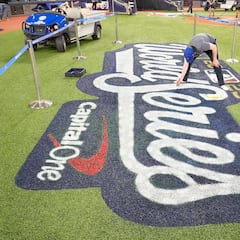It’s every fan’s dream at a baseball game to come away with one of the many balls being used during the game.

How many baseballs are used during a MLB game and how much do they cost?

It was during the fifth inning on 16 August (1920) when the Cleveland Indians’ Ray Chapman came to bat at the Polo Grounds. Carl Mays, recently acquired from the Boston Red Sox along with another young pitcher known as Babe Ruth, was on the mound for the Yankees, looking for his 100th win. Known to brush hitters back if they crowded the plate, Mays let loose with his submarine delivery. Chapman never even saw the ball. It struck him on the head, fracturing his skull, an injury which claimed his life twelve hours later.
Raymond Johnson Chapman’s death had several consequences for baseball, from the immediate banning of the spitball, to the eventual adoption of batting helmets, all designed to alleviate the symptom of being hit by a pitch, both in making the pitch more controllable as well as making the impact less life-threatening.
Baseballs looked different before Raymond Chapman, Cleveland Indians, was hit by a pitch in the temple by Yankees pitcher Carl Mays on August 17, 1920. He died 12 hours later. He couldn’t see the tobacco juice stained Baseball. Umpires began keeping white baseballs in the game. pic.twitter.com/GZSxTGuLMr
— Ron Butler (@racbutler) April 26, 2018
Another, more direct, consequence was a change that would forever alter the basic premise of the game, separating it permanently from its roots in England. This was the immediate adoption of a rule requiring the umpire to replace a ball once it became dirty. In a single fell swoop, baseball shifted from a strategic game where runs were eked out against a dominant pitcher, to a power-hitter’s paradise. It is no coincidence that 1920 saw the permanent shift from pitcher to outfield for the young Ruth.
Shohei Ohtani's 50th home run ball has sold at auction for nearly $4.4 million, a record-high price not just for a baseball, but for any ball in any sport.
— CBS News (@CBSNews) October 23, 2024
https://t.co/uP2nSb2l19
The emergence of Ruth for the Yankees, and the excitement that accompanied his blasts with the bat, are seen as the defining event that ended the “dead ball era” of baseball. But in reality, Ruth was a beneficiary of the ending of that era, not the catalyst. The true reason that home runs became such a staple part of the game is that the game was fundamentally altered by the new rule change. With a clean ball in play at all times, players no longer had to contend with a ball that “traveled through the air erratically, tended to soften in the later innings, and as it came over the plate, was very hard to see.”
100 years ago, baseball planted its flag firmly in the Lively Ball Era, thanks in part to the banning of "freak pitches" like the spitball. Babe Ruth and other sluggers took full advantage in the 1920s: https://t.co/F87VeUGhsb #SABRCentury pic.twitter.com/79X7nVvP5y
— SABR (@sabr) August 5, 2021
Where early baseball focused on what we today would call “small ball tactics”, and can readily be understood by simply watching a game of cricket, the constant use of a fresh baseball meant that the upper hand in the contest after 1920 was the one that held the stick, not the ball.
With a scuffed or dirty ball no longer useable in a game, the teams began to permit foul balls and home runs to be simply kept by fans as a souvenir. Previously, the crowd were not allowed to keep a ball and it had to be thrown back into the pitcher so that it could continue to be used in the game.
As this gradually became not only understood, but expected, Major League Baseball has had to devote ever-increasing sums to invest in game balls. Whereas the baseball game in which Chapman was killed would have used perhaps three or four balls at most, a modern game will churn through between seven and ten dozen baseballs.
That is 120 balls used per game. There are 2430 games in a season. That is 291,600 balls per year. Then we have the post season to contend with. With the playoffs, pennants, and World Series on the line, the umpires are, if anything, even more likely to swap out balls, whether they are dirty or not. The postseason can easily double the use of balls, and when you factor in extra-inning games and practice balls to the equation, it is not an unreasonable supposition to put the number of baseballs used by MLB to be in the region of 900,000.
This puts the annual MLB budget for baseballs alone in the $10 million range.
Mickey Mantle Signed Baseball - COA w/ Sticker - Rawlings Box - - MLB https://t.co/GiI1jsRAv1 pic.twitter.com/00Hs2RsMjx
— New York Yankees Collector (@YankeesCollect) July 2, 2022
Fans who go to the game and are lucky enough to catch a foul ball or home run will get to go home with a souvenir of their day. But often balls will be removed for all sorts of reasons. Umpires may have removed balls that became discolored or misshapen, but after more than a century since the rule was put into place, balls are removed once they are scuffed in any way, even by a foul tip or being thrown into the dirt.
Additionally, a pitcher can call for a new ball because they don’t like something about the feel. Perhaps it is too slick, or the seams don’t stand up enough, or any number of reasons. The request is almost never denied and the ball is usually, although not always, discarded by the umpire.
Related stories
Once a ball has gone out of play, it cannot be put back into play again, making the time-honored gesture of Cubs fans returning opposition home runs at Wrigley a purely symbolic move. The ball itself will likely be used to sign autographs or simply put into a pile for batting practice, but it will not be used again in the game.
For the last four decades, the sole supplier of baseballs to the Major Leagues has been Rawlings, and with a customer base of a single client who consumes over 80% of your production line annually, they look to have a golden business model.


Complete your personal details to comment